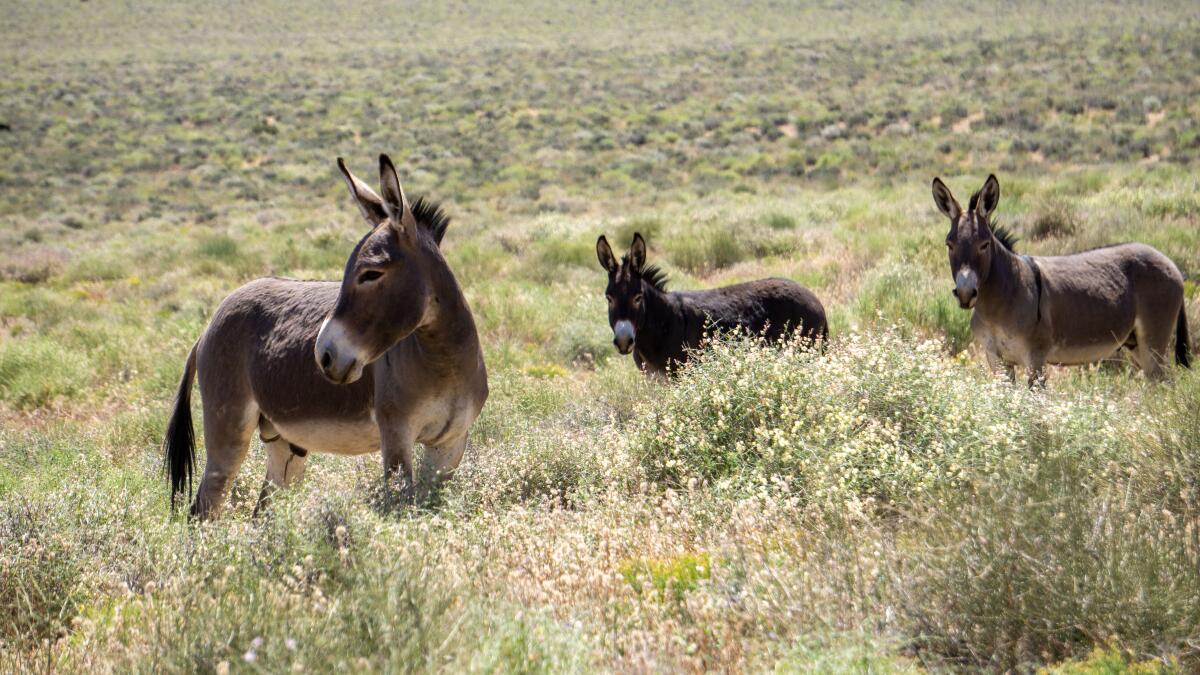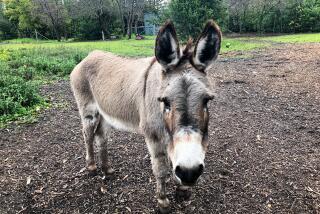Overrun by burros, San Bernardino County inks new deals to sterilize and relocate animals

- Share via
Burros were used by gold miners as pack animals in California more than a century ago. Today, wild donkeys teem in areas of San Bernardino County, where they have become a safety hazard on local roads.
To address the overpopulation problem, county officials have approved new deals with a local nonprofit to help sterilize and relocate many of the pint-size equines to sanctuaries.
“These partnerships reflect our commitment to local, compassionate and community-focused solutions for managing the wild burro population in San Bernardino County,” said Luther Snoke, county chief executive, at a Board of Supervisors meeting Tuesday.
DonkeyLand founder Amber LeVonne said in a statement that the rescue organization was “thrilled to continue to work with San Bernardino County under new contracts to support our local wild burros.”
Two contracts, which went into effect April 1, will help relocate orphaned, sick or injured wild donkeys, according to the county. Another contract would provide funding to DonkeyLand to castrate 100 donkeys within a year.
The county has also teamed up with the nonprofit to gather and transport burros to the DonkeyLand sanctuary. The organization has a wildlife preserve with more than 2,000 acres of space for wild burros and donkeys.
Donkeys or wild burros are descended from domesticated donkeys left behind by gold miners more than a century ago. The burros have roamed the pine forests and sagebrush fields of the Big Bear Valley area, but their numbers could overwhelm rare and endangered species of plants.
Scores of wild burros are trampling the ecology of Big Bear Valley and putting motorists at risk. Some say it’s time for an extermination program.
In addition, some locals have complained of destruction of private property and that the animals can be traffic hazards, endangering both residents and the burros.
Donkeys have been injured and killed in traffic collisions, according to county officials.
The county had previously worked with DonkeyLand, but county officials said there was disagreement about whether the organization had the ability to take in additional burros to their sanctuary in late 2024.
DonkeyLand officials, however, refuted the claim that they told the county they were at capacity.
“The county knows first-hand that we are capable of housing another 550 permanent residents,” the board of DonkeyLand wrote on Facebook. “It is unclear why they have expressed publicly that we are at capacity and yet they brought us several herds on December 12th, 2024.”
The county’s Department of Public Health decided to instead partner with the Peaceful Valley Donkey Rescue to capture and rescue nearly 256 burros in the unincorporated Reche Canyon region.
The county terminated that contract with Peaceful Valley on Jan. 24 after receiving negative feedback from supporters of DonkeyLand.
“PVDR and the County Department of Public Health have mutually agreed to conclude the contract for wild burro rescue and relocation services, signing a termination letter effective January 24, 2025,” according to the county’s Wild Burro Program web page.
More to Read
Sign up for Essential California
The most important California stories and recommendations in your inbox every morning.
You may occasionally receive promotional content from the Los Angeles Times.












